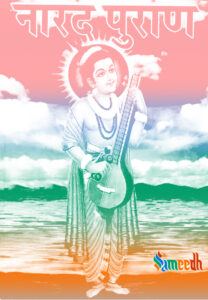The Narad Puran is one of the eighteen Mahāpurāṇs, a genre of ancient Indian texts. It is traditionally attributed to the sage Vyasa, who is also credited with compiling other major Puranas like the Mahabharat and the Bhagavat Puran. The Narad Puran is named after Sage Narad, who is a prominent character in Hindu mythology known for his devotion to Lord Vishnu and his role as a wandering sage and messenger of the gods.

The Puran is named after Sage Narad, who is a central character and an important figure in Hindu mythology. Narad is known for his devotion to Lord Vishnu, his musical skills, and his role as a wandering sage and celestial messenger. Like other Purans, the Narad Puran is divided into sections (khandas) and chapters (adhyayas). It consists of diverse content, including cosmology, mythology, legends, genealogies, religious teachings, and rituals.
The Narad Puran discusses the creation of the universe, the concept of time, and the cyclical nature of creation and dissolution (pralaya). The text contains numerous stories and myths, including those related to various deities, sages, and historical figures. These stories often convey moral and spiritual teachings.
The text extols the virtues of visiting sacred places and undertaking pilgrimages. It often describes the sanctity of particular Tirthas (holy places).The Narada Puran provides guidance on dharm(righteous living), rituals, and the worship of deities. It emphasizes devotion to Lord Vishnu and explores the paths of bhakti (devotion), karm (action), and jnana (knowledge).
- The Birth of Sage Narad:
- The Puran narrates the birth of Sage Narad, who is born from the mind of Lord Brahma. Narad is known for his devotion to Lord Vishnu and his role as a celestial sage and messenger.
- Narad and Prahlad:
- The Narad Puran features interactions between Sage Narad and Prahlad, the son of the demon king Hiranyakashipu. Narad imparts spiritual wisdom to Prahlad, emphasizing devotion to Lord Vishnu.
- The Churning of the Ocean (Samudra Manthan):
- The Purana includes the story of the churning of the cosmic ocean by the Devs (celestial beings) and Asurs (demons) to obtain the nectar of immortality (amrit). Lord Vishnu takes the form of Kurma (tortoise) during this episode.
- The Greatness of Pilgrimage Sites (Tirtha Mahatmya):
- Like many other Purans, the Narad Puran contains sections extolling the virtues of visiting sacred places. These narratives, known as Tirtha Mahatmya, describe the sanctity and spiritual significance of various pilgrimage sites.
- Story of Dhruv:
- The Narad Puran includes the story of Dhruv, a young boy who, through intense penance and devotion, attains a special place in the celestial sphere. Dhruv becomes the Pole Star due to his unwavering dedication to Lord Vishnu.
- Lord Shiv’s Manifestation as Ling:
- The Puran describes the origin of the Shiv Ling and explains its worship. It narrates how Lord Shiv, in the form of a fiery column of light, appeared to Brahma and Vishnu, challenging them to find His beginning and end.
- Narad and the Four Kumaras:
- Sage Narad encounters the Four Kumaras, the mind-born sons of Lord Brahma, who are renowned for their wisdom and celibacy. The encounter leads to philosophical discussions and teachings.
- The Story of Gajendra Moksh:
- The Narad Puran includes the story of Gajendra, the elephant, who is saved by Lord Vishnu from the clutches of a crocodile. This story illustrates the power of devotion and surrender.
These are just a few examples, and the Narad Puran is rich with various other stories, teachings, and philosophical discussions. The narratives within the Puran often serve to convey moral, ethical, and spiritual lessons within the context of Hindu philosophy.
It’s important to note that the content and emphasis of the Narad Puran may vary between different manuscripts and versions. Scholars and enthusiasts interested in the Purans often study multiple editions and translations to gain a comprehensive understanding of the text.